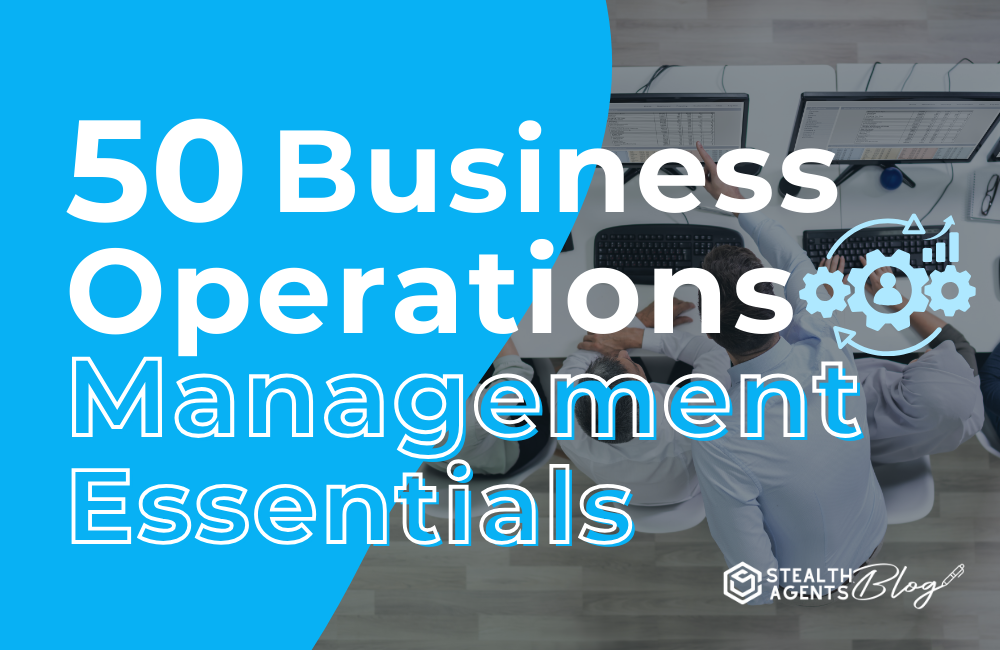Welcome to the world of Business Operations Management!
Whether you are starting your own business or working in a corporate setting, understanding the essentials of managing and scaling operations is crucial for success.
In this guide, we will cover 50 key aspects of business operations management that every entrepreneur and manager should know.
Effective operations management plays a critical role in the success and growth of any business. It involves overseeing all processes, resources, and activities that go into producing goods or providing services. By focusing on optimizing efficiency, productivity, and quality, operations management can lead to cost savings, improved customer satisfaction, and increased revenue. With the ever-changing business landscape and growing competition, having a solid understanding of business operations is essential for staying ahead and achieving sustainable success. So let’s dive in and explore the 50 essentials of business operations management!
-
Supply Chain Management: The end-to-end process of planning, sourcing, making, delivering, and returning products.
-
Inventory Management: The control and optimization of the quantity and location of inventory within a business.
-
Quality Control: Ensuring that products or services meet or exceed specified standards and customer expectations.
-
Capacity Planning: Assessing and adjusting the production capacity of a business to meet demand effectively.
-
Lean Manufacturing: Minimizing waste and maximizing efficiency in production processes.
-
Six Sigma: A set of techniques and tools for process improvement to reduce defects and improve quality.
-
Process Optimization: Streamlining and improving operational processes for increased efficiency.
-
Workflow Management: Designing, implementing, and optimizing workflows to enhance productivity and reduce bottlenecks.
-
Operations Planning and Scheduling: Creating plans and schedules to allocate resources and meet production targets.
-
Enterprise Resource Planning (ERP): Integrated software systems that manage various aspects of business operations.
-
Demand Forecasting: Predicting future customer demand to optimize production and inventory levels.
-
Procurement Management: Acquiring goods and services from external sources while optimizing costs and quality.
-
Logistics Management: Coordinating the movement of goods, services, and information throughout the supply chain.
-
Distribution and Fulfillment: Managing the storage, transportation, and delivery of products to customers.
-
Just-in-Time (JIT) Inventory: Keeping inventory levels minimal to reduce holding costs and waste.
-
Vendor Management: Developing and maintaining effective relationships with suppliers and vendors.
-
Risk Management: Identifying and mitigating potential risks that could impact operations.
-
Business Process Reengineering: Redesigning and restructuring business processes to achieve significant improvements.
-
Maintenance, Repair, and Operations (MRO): Managing the maintenance of equipment and facilities.
-
Operational Excellence: Continuous improvement of operations to achieve optimal performance.
-
Facility Layout Planning: Designing the physical arrangement of facilities for maximum efficiency.
-
Job Design and Workforce Planning: Structuring job roles and planning for workforce needs.
-
Time and Motion Studies: Analyzing work processes to improve efficiency and productivity.
-
Service Level Agreements (SLAs): Establishing agreed-upon standards for services provided.
-
Key Performance Indicators (KPIs): Measurable values that indicate the performance of a business in various areas.
-
Total Quality Management (TQM): A management approach focused on continuous quality improvement.
-
Benchmarking: Comparing performance metrics with industry best practices to identify areas for improvement.
-
Cross-Training: Training employees to perform multiple roles to enhance flexibility.
-
Sustainability Practices: Integrating environmentally and socially responsible practices into operations.
-
Change Management: Managing transitions and changes within the organization.
-
Task Automation: Implementing technology to automate repetitive tasks and processes.
-
Document Management: Organizing and controlling documents to facilitate efficient operations.
-
Cash Flow Management: Monitoring and managing the flow of cash within the business.
-
Risk Mitigation Strategies: Developing plans to minimize the impact of potential risks.
-
Customer Relationship Management (CRM): Managing interactions with customers to enhance relationships and satisfaction.
-
Outsourcing: Delegating certain business functions to external providers to optimize costs and focus on core competencies.
-
Process Mapping: Visual representation of business processes for analysis and improvement.
-
Human Resource Planning: Forecasting essentials future workforce needs and aligning them with business goals.
-
Data Analytics for Operations: Using data analysis to gain insights and optimize operational processes.
-
Balanced Scorecard: A strategic planning and management system to monitor and improve performance.
-
Cycle Time Reduction: Minimizing the time it takes to complete a process or produce a product.
-
Emergency Preparedness and Business Continuity: Planning for and responding to unforeseen disruptions.
-
Energy Efficiency: Implementing practices and technologies to reduce energy consumption.
-
Regulatory Compliance: Ensuring operations adhere to relevant laws and regulations.
-
Customer Service Operations: Managing processes to deliver quality customer service.
-
Employee Training and Development: Providing ongoing training to enhance skills and knowledge.
-
Cash Conversion Cycle: Managing the time it takes to convert sales into cash.
-
Strategic Outsourcing: Outsourcing decisions aligned with overall business strategy.
-
Innovative Technologies Integration: Adopting emerging technologies to improve operations.
-
Continuous Improvement Culture: Fostering a mindset of ongoing improvement within the organization.
Conclusion
In conclusion, understanding and implementing the 50 essentials of business operations management is crucial for any successful organization. From effective communication to strategic planning, these essentials play a vital role in streamlining processes, reducing costs, and increasing overall efficiency. By prioritizing these key areas, businesses can achieve their goals and stay ahead in today’s competitive market. Remember to continuously review and improve upon these essentials to stay at the top of your game. Let these essentials be the foundation for a successful and thriving business operation.











